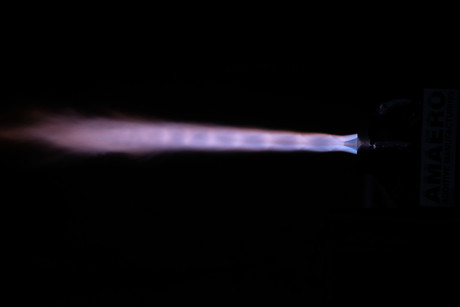Australian researchers build first 3D-printed rocket engine

Two years ago, Monash University researchers and their partners were the first in the world to print a jet engine, based on an existing engine design. That work led to Monash spin-out company Amaero winning contracts with major aerospace companies around the world.
Now a team of engineering researchers have accepted a challenge from Amaero to design a rocket engine. Amaero printed its design, and the researchers test-fired it, all in just four months. Their joint achievement illustrates the potential of additive manufacturing (or 3D printing) for Australian industry.
The Monash engineers have now created a new venture, NextAero, to take their concepts to the global aerospace industry, starting with the International Astronautical Congress in Adelaide, 25–29 September.
The new rocket engine has a unique aerospike design which turns the traditional engine shape inside out. Such a design is not practical to build using conventional techniques.
“Traditional bell-shaped rockets, as seen on the Space Shuttle, work at peak efficiency at ground level. As they climb the flame spreads out reducing thrust. The aerospike design maintains its efficiency but is very hard to build using traditional technology,” said Marten Jurg, an engineer with Amaero. “Using additive manufacturing we can create complex designs, print them, test them, tweak them and reprint them in days instead of months.”
Access to Amaero’s additive manufacturing expertise enabled NextAero to play to its strengths. “Designing for additive manufacture opens up a raft of possibilities,” said Graham Bell, the NextAero project lead. “We were able to focus on the features that boost the engine’s performance, including the nozzle geometry and the embedded cooling network. These are normally balanced against the need to consider how on earth someone is going to manufacture such a complex piece of equipment. Not so with additive manufacturing.”
“Going from concept to testing in just four months is an amazing achievement,” said Professor Nick Birbilis, head of the Material Science and Engineering Department at Monash. “It illustrates what’s possible for research and industry. Through our spin-out company, Amaero, Australian companies can design, print and test metal components for everything from aerospace to surgical instruments, hose fittings to air conditioning parts,” he said.
The development of the aerospike rocket was supported by Monash University, Amaero Engineering and Woodside Energy through the Woodside Innovation Centre at Monash.
DroneShield nabs another European military contract
DroneShield has recently announced it has received a new contract for AU$49.6 million for...
Daikin Australia opens new Sydney factory
Daikin Australia has opened a new factory in Chipping Norton that aims to accelerate the...
AR3 to be first to process rare earths at ANSTO's new pilot facility
Australian Rare Earths has announced that it will be the first industry partner to access...











